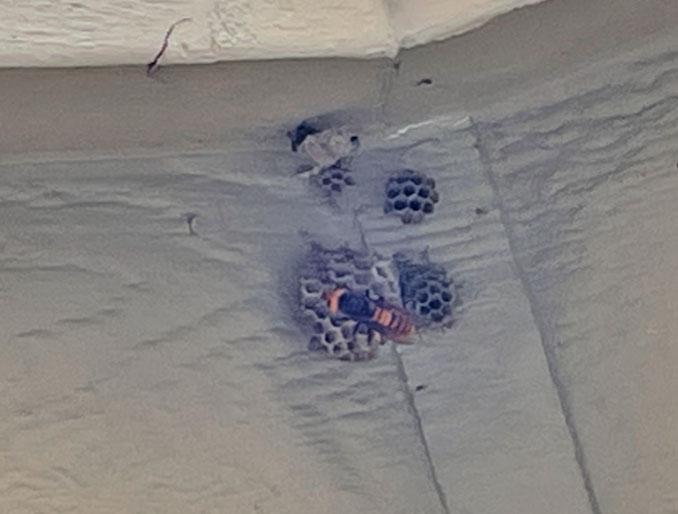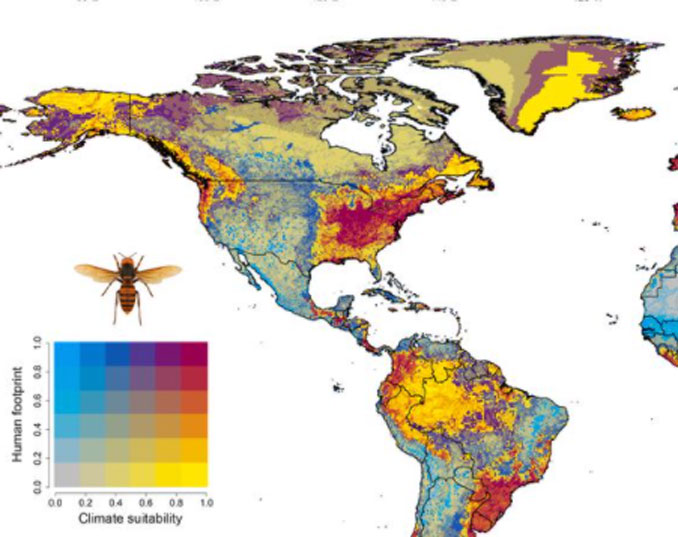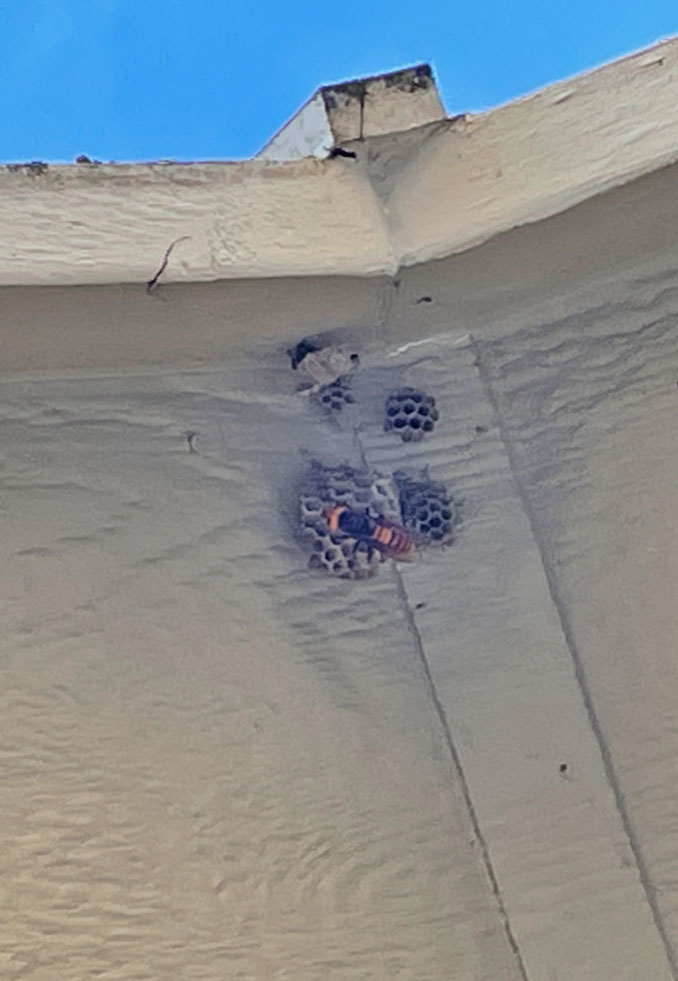
OLYMPIA – The Washington State Department of Agriculture (WSDA) has confirmed the first report of a live Asian giant hornet sighting in Washington in 2021. Residents in the area have been anxiously waiting to learn whether any Asian giant hornets (Vespa mandarinia) would appear again this year after a nest was eradicated on October 24, 2020 in Blaine, Washington. There was a known risk that fertilized queens could have already fled the nest that was eradicated in October 2020, or there was a possibility there was at least one other nest that was never detected in the area.
The live hornet report for 2021 was submitted by a Whatcom County resident on Wednesday, August 11, 2021. WSDA entomologists reviewed and confirmed the report as an Asian giant hornet on August 12, 2021. The report included a photograph of an Asian giant hornet attacking a paper wasp nest in a rural area east of Blaine, about 2 miles from where WSDA eradicated the first Asian giant hornet nest in the United States in October 2020, according to the WSDA. Blaine is located in the far northwest corner of Whatcom County.
“This hornet is exhibiting the same behavior we saw last year – attacking paper wasp nests,” Sven Spichiger, WSDA managing entomologist said to area residents. “If you have paper wasp nests on your property and live in the area, keep an eye on them and report any Asian giant hornets you see. Note the direction they fly off to as well.”
In response to this detection, WSDA will be setting live traps in the area in an attempt to catch a live hornet, tag it, and track it back to the nest. The British Columbia government will likewise be setting additional traps in Canada as this detection was approximately half a mile from the U.S./Canadian border.
Public reports of Asian giant hornet sightings continue to be critical to locating the pest. In 2020, half of WSDA’s confirmed reports and all of Canada’s confirmed reports came from the public. This year there have only been two confirmed reports in Washington and both were from public reports [Note: Not sure what WSDA means since the opening paragraph of their news release reports the first report of a live Asian giant hornet; could be the other hornet was dead. According to an earlier Facebook post on the Asian Giant Hornet Watch page, a very dried out male was found in Snohomish County that is unrelated to the Whatcom County detections from 2020.]. There have been no confirmed reports in B.C. While WSDA, cooperators, and the public have set Asian giant hornet traps throughout the state, there have not yet been any detections in traps in 2021.
Asian giant hornets are an invasive pest not native to the U.S. They are the world’s largest hornet and prey on honey bees and other insects. These hornets may attack honey bee hives in the late summer or early fall. A small group of Asian giant hornets can kill an entire honey bee hive in a matter of hours.

While no Asian giant hornets have been officially confirmed in Illinois, scientists have named Illinois as part of a geographic area with high climate suitability for the existence of Asian giant hornets. Authorities in Washington do not know how the Asian giant hornet became an invasive species in their state, but have speculated some type of stowaway invasion may have occurred — accidentally or intentionally. Technically a fertilized queen Asian giant hornet would need to enter the state, or an entire nest would have to be smuggled into the state or nearby British Columbia. In Washington, some have speculated that the Asian giant hornet may have arrived in a shipping container aboard a ship on trip over the Pacific Ocean. In Illinois, one could speculate that a fertilized queen could enter Illinois as a stowaway on a cargo jet at O’Hare International Airport.
There was an unofficial sighting of an Asian giant hornet with no photographic evidence on Sunday, July 29, 2012 in Arlington Heights, Illinois. The insect sighted had the distinguishing characteristics of a 2-inch long Asian giant hornet — a bright orange plastic-looking head (like a bathtub toy) and wide solid strips on the body. Two wasp- or hornet-like insects that are comparable in size and established in Illinois are the European hornet and the Eastern cicada killer wasp, but the European hornet has a darker, less impressive burnt-orange head and lacks wide solid strips; and the Eastern cicada killer is colored black and cream-yellow with a dark head.
Asian giant hornets are controversially called “Murder Hornets” by the news media and the public. Some news media clarify that the word “murder” refers to how quickly Asian giant hornets can decimate an entire bee hive, rob the honeybee larvae, and bring the larvae back to their own nest to feed their own young. However, Asian giant hornets have been known to kill human beings, especially from multiple stings from multiple hornets. Asian giant hornets build their nests in trees and in the ground, and an unlucky encounter could be deadly to humans. Accidentally stepping on a nest or getting too close to a nest (for example less than 20 feet) could be deadly. In 2013, at least 41 people were killed and over 1,600 people were injured by stings from Asian giant hornets when nest infestations occurred in China. Deaths have been attributed to anaphylaxis, cardiotoxicity, and multiple organ failure.
There have also been deadly encounters in Japan. Scientists affiliated with the Department of Traumatology and Critical Care Medicine, National Defense Medical College, Saitama, Japan analyzed 15 Japanese human cases that involved multiple organ failure induced by stings from Asian giant hornet (Vespa mandarinia). Thirteen of 15 cases were associated with skin hemorrhage or necrosis after Asian giant hornet stings. The mean number of stings in the patients who died was 59, which was significantly greater than the mean number of stings among people who survived (28 stings).
REPORTING AGH SIGHTINGS IN WASHINGTON STATE
Visiting WSDA’s website at agr.wa.gov/hornets is the best way to report suspected hornet sightings. The online reporting form allows you to upload photos as well as to indicate on a map where the sighting occurred. Alternatively, sightings can be emailed to [email protected] or can be reported at 1-800-443-6684.

REFERENCE:
Yanagawa Y, Morita K, Sugiura T, Okada Y. Cutaneous hemorrhage or necrosis findings after Vespa mandarinia (wasp) stings may predict the occurrence of multiple organ injury: a case report and review of literature. Clin Toxicol (Phila). 2007 Oct-Nov;45(7):803-7. doi: 10.1080/15563650701664871. PMID: 17952752.
^^ MOBILE? USE VOICE MIC ^^
facebook …
Please ‘LIKE’ the ‘Arlington Cardinal Page. See all of The Cardinal Facebook fan pages at Arlingtoncardinal.com/about/facebook …
Help fund The Cardinal Arlingtoncardinal.com/sponsor
20240105-1435future
THANKS FOR READING CARDINAL NEWS
Whatcom County is located in the northwestern corner of the U.S. state of Washington, bordered by the Canadian Lower Mainland (British Columbia) to the north, the Okanogan County to the east, the Skagit County and San Juan County to the south and southwest, and the Salish Sea to the west.
